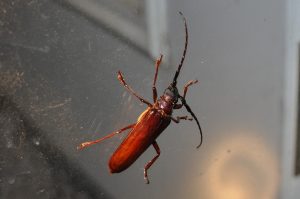
This is an alien. Actually it’s not. It’s the brown prionid [Orthosoma brunneum] and it probably lives closer to you than this picture would have you believe. It is a long-horned beetle native to the eastern half of North America. The adults are usually seen during the summer months from June to August and they can be almost twice as long as an iPod shuffle. They mate and lay their eggs during this time either in or on decaying wood or in the soil. However, iNaturalist reports that the vast majority of sightings it has catalogued from its members were in July. They have a graph that shows the number of sightings over the year, which clearly peaks in July, and they also have a map of all sightings reported to them. Brown prionids are relatively common throughout their range.
Well, anybody who looks at this picture probably assumes that they are xenomorphs from Zeta Reticuli. That is, as a matter of fact, not true. Its larval stage can be found living, eating, and growing inside rotting pine logs on the forest floor. The adult female finds a rotting log to lay her eggs in and for her larvae to grow up in. She does this by detecting high carbon dioxide levels from the decay of the wood using her palps, which are finger-like projections on her head. As they move along and eat the rotting wood, the larvae create tunnels and subsequently fill them with their poop as they bore through the wood. The larvae can digest the fiber in wood by eating fungi growing in the rotting logs along with the fungi’s enzymes that help break the fiber down. Luckily, they offer no reason for humans to worry; they are vegans and no part of their life cycle will hug your face. However, according to whatsthatbug, these beasts have strong mandibles that can give a painful bite, and that can even draw blood if not handled correctly. Adults have been observed to go after rotting fruit set out as bait and they are attracted to light.
They used to be classified in the same group as the Palo Verde beetle of Arizona, which is a similar looking beetle that is bigger and that is about as aerodynamic as a rock, according to anecdotal sources. Despite his mischaracterization of these graceful creatures, Harvey Epperson Savely Jr. had the foresight to provide a small amount of insight into the childhoods of these stellar insects (stellar as in they live inside rotting trees). He suggests, based on his observations, that only two or three of these larvae will be found in any given log at a time. He also points out that the larvae of the brown prionid like to hang out in the same logs as the larvae of the blind click beetle, which looks like it has two bottomless eyes on its back as an adult. As exciting as rotting pine logs are, the brown prionid can be more than just a grub inside a log. This brown prionid grub actually was found inside a moist wooden plank that was part of the structure of a 1.5 million dollar home. These beetles also like to lay their eggs in utility poles and railroad ties.
After a sometimes luxurious larvae hood, the brown prionid will enter the next phase of its life cycle, the pupal stage, or the thing that looks like a newborn xenomorph. This is the stage in between larvae hood and adulthood. The adult brown prionid will at first not be brown. It will be white after it sheds its pupal skin. Its exoskeleton will then harden and turn brown, and it will chew its way out of the log and into the world. The adults look like this, and you’ll believe it when you hear it, they aren’t all looks. If you watch this video, you will hear why it is called the squeaking beetle.
The brown prionid is a beetle that spends its childhood in rotting logs, makes poop tunnels, hangs out with click beetles that grow up to look like Halloween decorations, and squeaks, among many other talents. It is most certainly not an alien, and it is probably closer than you think if you live on the east coast.
Truly appreciate your well-written posts. I have certainly picked up valuable insights from your page. Here is mine 85N about Cosmetics. Feel free to visit soon.
You made some really good points on your post. Definitely worth bookmarking for revisiting. Also, visit my website UY5 for content about Thai-Massage.